Camping in cold weather can be a magical experience. The crisp air, the peaceful solitude of a quiet, snowy forest, and the chance to witness stunning winter landscapes make it all worthwhile. However, the chill of the night can quickly turn from enchanting to unbearable if you’re not prepared.
Staying warm while camping in the cold requires a blend of proper gear, smart techniques, and a bit of know-how.
Whether you’re a seasoned winter camper or a beginner looking to extend your camping season, this guide will arm you with all the survival tips you need for a cozy and memorable adventure.
Understanding Cold-Weather Camping
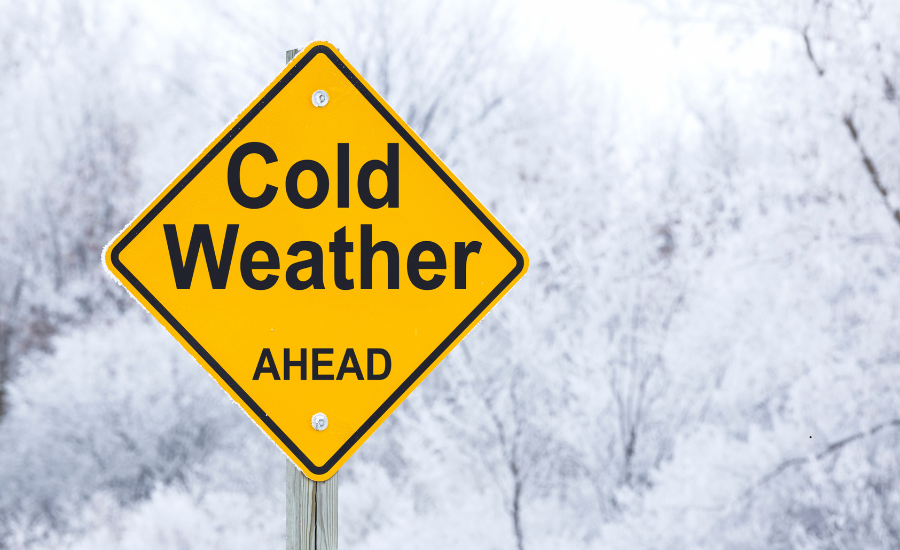
Cold weather camping demands preparation and resilience; it’s notoriously more unpredictable. Understanding its challenges—freezing temps, gear needs, and safety risks—ensures comfort and survival. It’s not just camping; it’s mastering nature’s extremes. Learn, prepare, and embrace the cold with confidence. The rewards? Stunning winter landscapes, serenity, and the triumph of thriving in nature’s toughest conditions.
Why Cold-Weather Camping Can Be Magical
There’s a unique charm to cold-weather camping that summer trips just can’t match. Imagine the serenity of snow-covered trees, the stillness of a frozen lake, or the sparkle of frost under a full moon. You’re likely to find fewer crowds and more wildlife. It’s a chance to experience nature in its purest, most tranquil form.
The crisp, clean air is invigorating, and the sense of adventure is heightened as you brave the elements. It’s not just camping; it’s an escape into a winter wonderland.
Recognizing the Risks: Hypothermia and Frostbite
While the winter landscape can be beautiful, it also comes with risks. Hypothermia and frostbite are real dangers in cold-weather camping. Hypothermia occurs when your body loses heat faster than it can produce it, leading to a dangerously low core temperature. Early signs include shivering, confusion, and slurred speech.
Frostbite, on the other hand, happens when your skin and underlying tissues freeze, often affecting extremities like fingers, toes, and the nose. Numbness and a pale or waxy appearance are warning signs. Knowing the symptoms and acting quickly can make all the difference.
Preparing for Temperature Drops: What to Expect
Temperatures can plummet quickly during the fall and winter months in the wilderness, especially after the sun sets. Even if the daytime is mild, nights can be frigid. Be prepared for sudden changes by checking weather forecasts and packing for colder conditions than expected. Bringing extra layers and a reliable heat source is essential. When in doubt, assume it will be colder than predicted.
It’s also a great idea to learn or brush up on your skills at building quick and simple camping shelters!
Choosing the Right Gear for Cold Weather
Stay warm, stay safe! The right gear for cold-weather camping ensures comfort, prevents hypothermia, and lets you fully enjoy nature’s winter beauty. Gear up smart and you will adventure confidently.
The Importance of a High-Quality Sleeping Bag
Even more than your tent, your sleeping bag is your best friend in cold-weather camping. Look for a high-quality, four-season bag rated for temperatures well below what you expect. A mummy-style sleeping bag with a hood will trap heat more efficiently, keeping your entire body warm. Down insulation offers excellent warmth-to-weight ratio but can lose insulation power when wet. Synthetic bags, though heavier, maintain warmth even if damp.
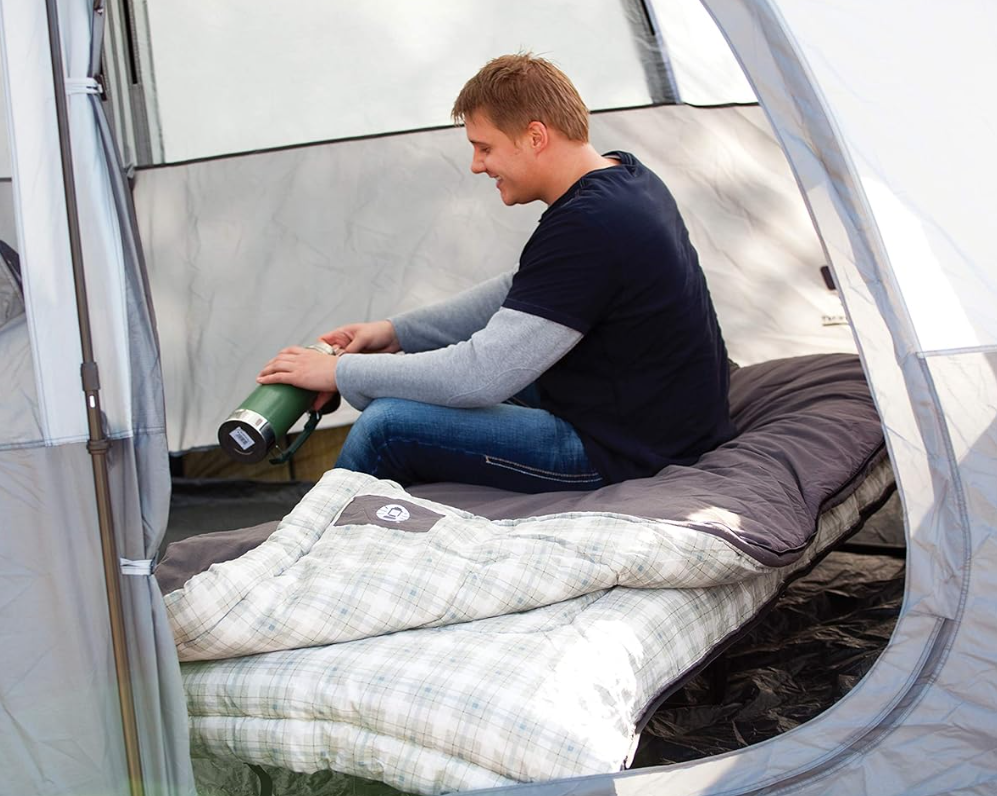
Ideal thermal sleeping bag for all-weather comfort and survival.
Fits adults up to 6’5″. 4.7-star rating.
How to Choose an Insulated Sleeping Pad
A good sleeping pad isn’t just for comfort—it’s a barrier against the cold ground. Choose an insulated pad with a high R-value (thermal resistance) to keep the chill from creeping up from beneath. Double up with a foam pad under your inflatable one for extra warmth and stability.
Tips for Selecting the Best Cold-Weather Tent
A proper cold-weather tent is crucial. Look for a four-season tent designed to withstand snow loads and high winds. Features like double walls and a full-coverage rainfly help retain heat. Ensure the tent has good ventilation to reduce condensation, which can make you feel colder.
Layering Up: How to Dress for Warmth
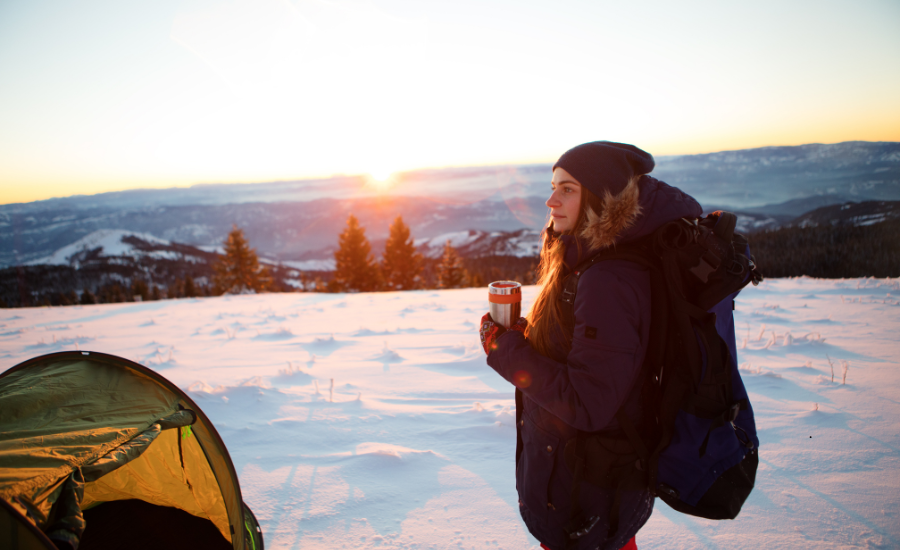
Mastering layering for cold-weather camping is your key to comfort and safety. Proper layers trap heat, wick moisture, and shield against the elements. Prepare wisely, and the cold becomes your companion, not your challenge. Here are the stages of layering that are essential…
The Base Layer: Moisture-Wicking Essentials
Start with a moisture-wicking base layer to keep sweat off your skin. Choose materials like merino wool or synthetic fabrics that pull moisture away, keeping you dry and warm. Avoid cotton, as it holds moisture and can leave you feeling damp and chilled.
Mid-Layers for Insulation: Fleece vs. Down
The mid-layer is your insulation. Fleece is great for trapping heat while allowing breathability. Down jackets are unbeatable for warmth but can lose their insulating power if wet. Consider a fleece-lined waterproof jacket to offer a good balance of warmth and moisture resistance.
The Outer Layer: Windproof and Waterproof Options
Your outer layer should be windproof and waterproof to shield you from the elements. A hardshell jacket with sealed seams offers the best protection. Look for breathable fabrics like Gore-Tex to prevent overheating while keeping you dry.
Don’t Forget the Extremities: Hats, Gloves, and Socks
You can lose a lot of heat through your head, hands, and feet. Wear a wool or fleece hat, insulated gloves, and thick, moisture-wicking socks. Consider layering thinner gloves under thicker ones for added warmth.
Setting Up a Warm Campsite
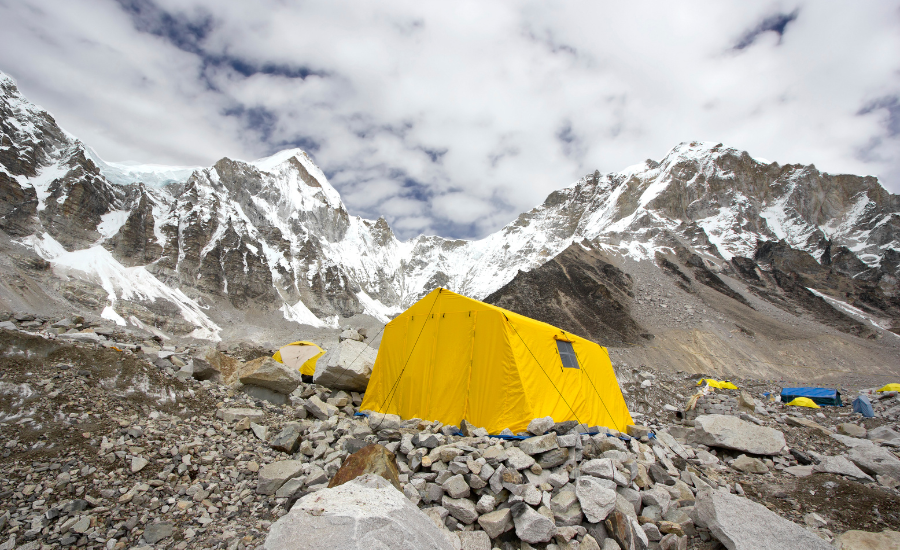
A warm campsite is key to enjoying cold-weather camping. Without a great night of sleep, things can quickly become more miserable than magical. Mastering setup skills like proper layering, insulating your tent, and managing heat sources allows you to stay focused on the fun. Every camper should begin first with standard safe camping practices in mind. From there, modify your setup for a colder climate.
Picking the Best Spot: Sheltered Locations
Choose a campsite that’s sheltered from the wind. Look for natural barriers like trees or rocks. Avoid setting up at the bottom of a valley where cold air tends to settle.
Building a Reflective Campfire for Extra Heat
A campfire isn’t just for roasting marshmallows—it’s a source of warmth. Use a natural windbreak, as described above if possible, or build a reflective wall of logs or rocks behind your fire to bounce heat back toward you. This simple trick can make a huge difference in your comfort. Here is a great video tutorial for how to build a safe reflector for your campfire:
Creating a Natural Windbreak with Your Surroundings
First, determine which way the wind is likely to come in the strongest, then use what nature provides. Set up your tent behind a boulder or build a snow wall to act as a windbreak. A bit of basic evaluation and preparation can significantly reduce wind chill and keep your campsite cozier.
Hot Tips for Staying Warm at Night
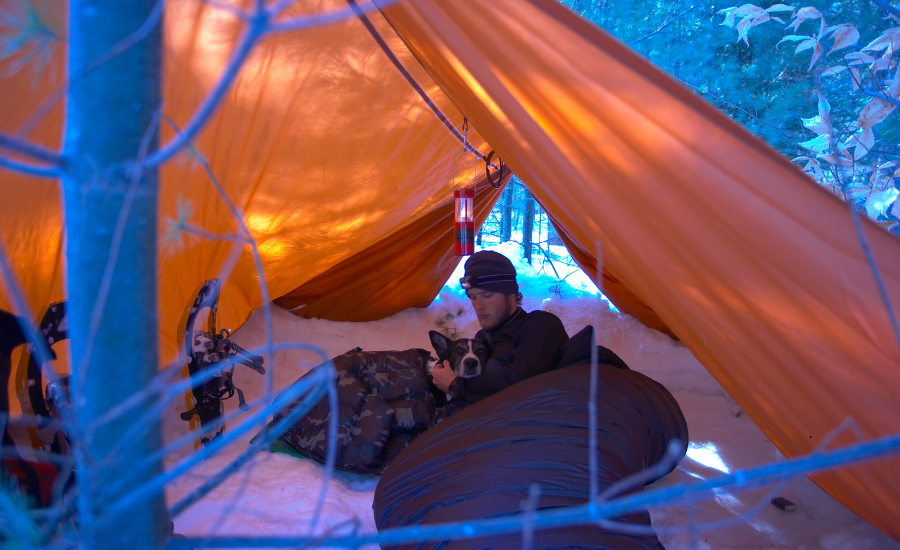
People generate body heat, so family camping is ideal for colder climates. But if you are traveling solo, bring your furry family — you’ll be toasty in no time!
How to Heat Up Your Sleeping Bag with a Hot Water Bottle
Fill a sturdy, leak-proof hot water bottle with boiling water and tuck it into your sleeping bag before bed. These are commonly used for pain relief, but place one near your core or at your feet for a toasty night’s sleep.
Using Hand Warmers and Body Warmers Safely
Chemical hand warmers are great for quick heat. Slip them into your gloves, socks, or sleeping bag. Be sure to follow safety instructions to avoid burns.
Why You Should Avoid Sleeping in Tight Clothing
Tight clothing can restrict circulation, making you feel colder. Opt for loose, warm layers that allow blood to flow freely and trap heat effectively.
Warm Foods and Drinks for Cold-Weather Camping
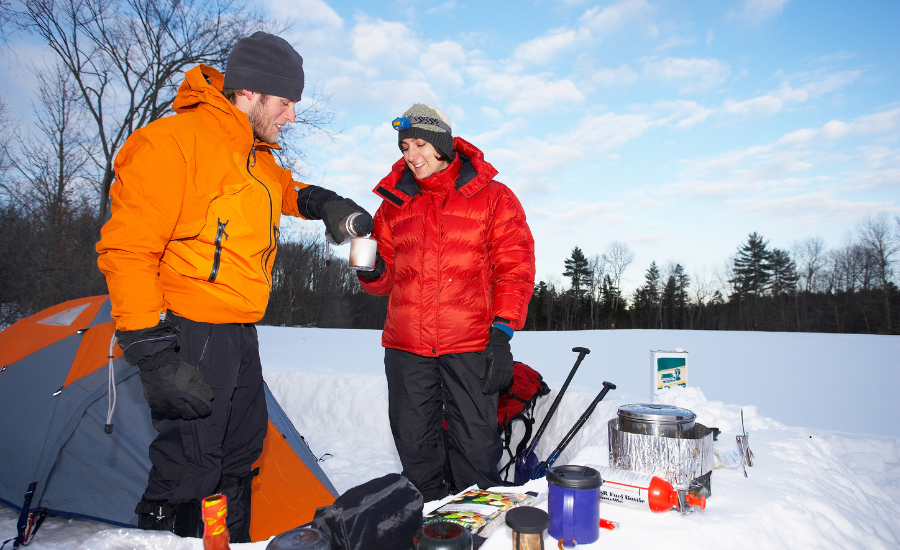
Staying warm while camping isn’t just about layering clothes—warm foods and drinks are vital! They boost body heat, energy, and morale in cold conditions. A hearty meal or hot drink can prevent hypothermia, improve circulation, and keep spirits high. Choose your backpacking stove wisely, bring a high-quality thermos and enjoy!
Best Hot Meals to Boost Your Body Heat
Hearty stews, soups, and oatmeal are excellent choices. They’re not only filling but also help warm you from the inside out. Consider pre-cooking meals at home for easy, quick heating at the campsite.
The Magic of Warm Drinks: Hot Cocoa, Tea, and Broths
Sipping on hot beverages is a simple yet effective way to warm up. Choose drinks like hot cocoa, herbal tea, or bone broth for a comforting and hydrating boost.
Avoid Alcohol! Why It Can Make You Colder
While alcohol might give you a warm feeling initially — and certainly might make you forget any discomfort for a little bit — it actually lowers your core temperature and can be incredibly dangerous. Skip the nightcap and stick to non-alcoholic warm drinks instead.
Staying Active to Keep Warm
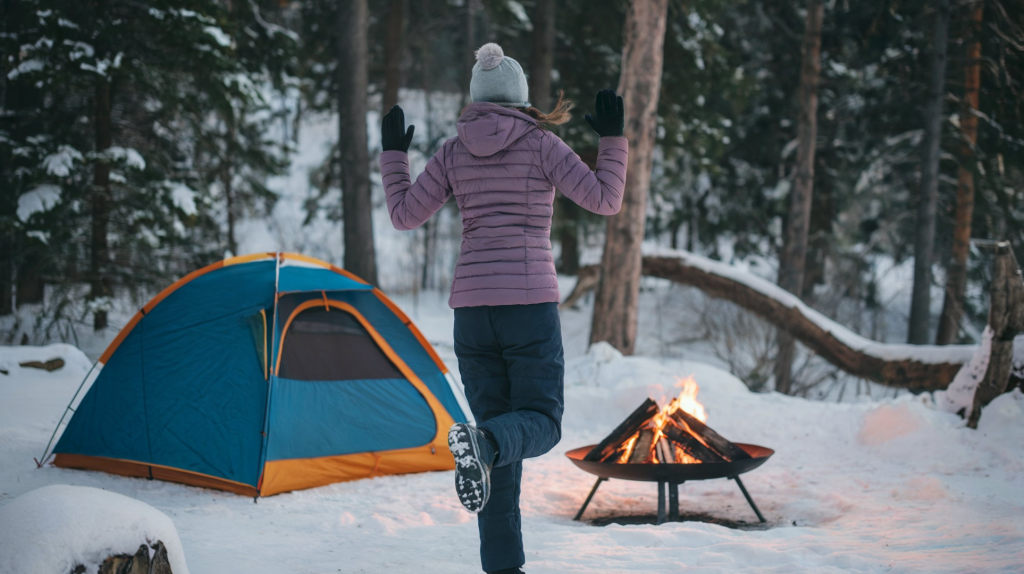
Do some light exercises like jumping jacks or brisk walking to get your blood flowing. This generates heat and helps you warm up quickly.
Staying still for too long can make you feel colder. Get up and move around periodically to keep your body temperature up.
But Avoid Sweating!
Too much activity can make you sweat, which can be dangerous in cold weather. Sweat cools your body, so find a balance that keeps you warm without getting damp.
Final Tips and Tricks for Staying Warm
- Always check your camping weather forecast and be prepared for unexpected changes. Bring extra layers just in case even if you think they won’t be necessary.
- Follow instructions carefully when using heat packs or portable heaters to avoid burns or carbon monoxide poisoning, especially in heavily snowed-in conditions.
- Learn from those who’ve braved the cold before. Tips and tricks from online communities of experienced campers can make your experience safer and more enjoyable.
Winter camping can be a rewarding adventure if you’re well-prepared. With these tips, you’ll stay warm, safe, and ready to enjoy all the wonders of the cold outdoors. So bundle up, embrace the chill, and let the snowy landscapes enchant you.
Happy camping! ⛺🔥
See Our Latest Posts
- 21 Fun Camping Games to Entertain Yourself Outdoors
- How to Set Up a Hammock for Camping
- Compact Camping Gear That Saves Space in Your RV or Van
- Top 15 Most Beautiful Waterfalls In The World To Visit In Your Lifetime
- Top 12 Camping Gadgets and Accessories You Didn’t Know You Needed (2025)
Write A Guest Post For Us!
Are you passionate about camping and the great outdoors?
We’re excited to announce that we’re accepting guest posts
in the camping and outdoor niche!

